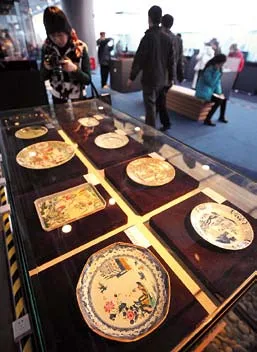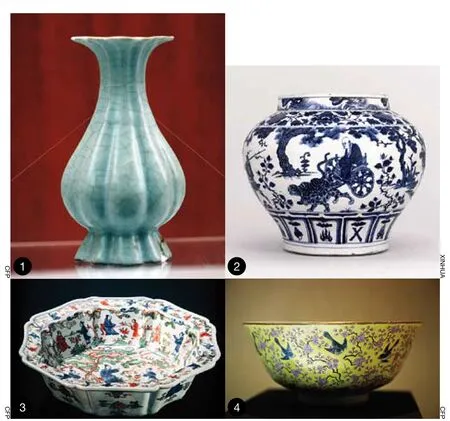Prosperity in Porcelain
2010-09-12ByZHOUSHANGYUN
By ZHOU SHANGYUN
Prosperity in Porcelain
By ZHOU SHANGYUN
Porcelain is generally believed to have originated in China, the reason it is also called “china” in the West. The production of pottery in China dates back some 10,000 years.
Development
Proto-celadon, predecessor of porcelain and the transition state from pottery to porcelain, appeared during the Shang and Western Zhou dynasties (1600-771 B.C.), and porcelain production started no later than the Eastern Han Dynasty (25-220).
Since the 1970s, a number of celadon shards featuring delicate textures and glossy glazes were unearthed from the Han Dynasty (202 B.C.-A.D. 220) kiln sites in south China. Porcelain ware in varied shapes was also found in tombs of that period, showing high-fring glazed pottery had developed into porcelain by that time.
During the 300-odd years following the Han Dynasty, in comparison with the warridden north China, the area of the lower reaches of the Yangtze River was much more stable, favoring the development of porcelain making.
Great numbers of kilns were built in Shaoxing, Yuhang and Wuxing—all in today’s Zhejiang Province—where similar types of porcelain were produced, which helped to form the style of the Yue Kiln. Kilns in this area mostly produced celadon and black porcelain. In the late Western Jin Dynasty (265-316), green glazed porcelain decorated with brown spots was also produced there.
The porcelain of this style featured hard and fne roughcast and was light grey in color. The types of products expanded too, including bowls, trays, saucers, platters, jars, pots, incense burners and candlesticks.
When Buddhism prevailed in the Southern Dynasties (420-589), porcelain products were typically decorated with lotus fowers.
张清元在陈二白家住过一段时间后,就被区上的干部接走了,安置在河口高地上的孤儿院。那孤儿院是县上出资办的,专门收容因战乱遗留下来的孤儿。张清元虽然不是战乱遗留下来的孤儿,但毙他爹毕竟有政策上的漏洞,而且他娘也死了,区公所就派专人把他也接了过去。
Besides the Yue Kiln, other noted porcelain kilns in the south of the country included the Deqing Kiln (Zhejiang Province), Wuzhou Kiln (Zhejiang Province), Xiangyin Kiln (Hunan Province) and Fengcheng Kiln (Jiangxi Province).
Compared to the south, porcelain production started a little later in the north. As a result of low iron content in kaolin in the north, mostly white porcelain was produced there. Four green glazed porcelain vessels with lotus patterns unearthed from a tomb in today’s Hebei Province are rated as representative works of north China’s porcelain produced in that period and show fne art in their making.
The ceramic industry in China reached a new stage during the Sui and Tang dynasties and the period of Five Dynasties and Ten Kingdoms, which lasted from 518 to 960.
Kilns in the south, with the Yue Kiln as their centerpiece, enjoyed a reputation for celadon porcelain production, while kilns in the north, with Xing Kiln (Hebei Province) as a representative, became known for their white porcelain.
The two types of products featured distinct regional flavor, attained a high degree of technical perfection, and represented the country’s highest level of porcelain making at that time. Both the north and the south witnessed an ever-growing trend toward thinner roughcast, smoother glaze, and more exquisite and ingenious shapes.
Porcelain production continued to boom in the Liao, Song, Western Xia and Jin dynasties, a period from 916 to 1234. Well-known kilns spread all over the country, leading to the forming of eight major kiln styles—the Ding (Hebei Province), Jun (Henan Province), Yaozhou (Shaanxi Province) and Cizhou (Hebei Province) kilns in the north, and the Jingdezhen (Jiangxi Province), Longquan (Zhejiang Province), Jian (Fujian Province) and Yue (Zhejiang Province) kilns in the south.
Further, fve celebrated kilns during the Song Dynasty (960-1279), which were Guan (imperial kiln), Ge, Ru, Ding and Jun kilns, became well-known for the production of fne porcelain, leading to a peak of China’s porcelain production.
In the Yuan Dynasty (1206-1368), the country’s porcelain-making techniques reached a higher level. In 1278, an imperial kiln was set up in Jingdezhen, Jiangxi Province. From then on Jingdezhen gradually developed into a porcelain production center for the country. With the invention of blue and white porcelain and underglaze red porcelain of kilns there, a new chapter of China’s porcelain history started.

ANCIENT TRADING: (Left) An exhibition of China’s porcelain ware produced for export during the Qing Dynasty (1644-1911) is held in Beijingin February 2010

An export-oriented porcelain product of Qing Dynasty (1644-1911)
Blue and white porcelain was made by heating clay roughcast painted with blue pig-ment, generally cobalt oxide, under the glaze to a temperature of 1,300 degrees centigrade or so. Featuring strong Chinese national styles, this type of porcelain has been the dominant product for hundreds of years. Once invented, this blue and white porcelain was favored overseas and sold well. It remained in great demand for a long time, and became the embodiment of Chinese porcelain. (See P.41)

PORCELAIN TREASURES: 1. A green glazed porcelain vase of the Song Dynasty (960-1279) 2. A blue and white porcelain jar of the Yuan Dynasty (1206-1368) 3. A painted porcelain utensil of the Ming Dynasty (1368-1644) 4. A porcelain bowl of the Qing Dynasty (1644-1911)
The country’s porcelain making had its heyday during the Ming (1368-1644) and Qing (1636-1911) dynasties. Enjoying fame as “Porcelain Capital” for over 500 years, Jingdezhen produced a great variety of porcelain items in different colors and shapes, including numerous priceless porcelain works. The products of Jingdezhen not only served for the imperial families, but also enjoyed good sales both in and out of the country.
But, in the late period of the Qing Dynasty, China was hit by domestic social instability and foreign invasion. Given the unstable social environment, the country’s ceramic industry waned rapidly.
Exporting
As early asthe Western Han Dynasty (206 B.C.-A.D. 25), Zhang Qian, an envoy of the court of Han, was sent on diplomatic missions to kingdoms in the Western region (referring to areas west of Yumen Pass, including China’s Xinjiang Uygur Autonomous Region and parts of Central Asia), thus opening up the overland Silk Road, the famous trade route connecting the East and the West.
The exporting of Chinese porcelain started in the end of the eighth century. With the prosperity of the maritime Silk Road during the Tang and Song dynasties (618-1279), Chinese porcelain, such as white porcelain of the Xing Kiln, celadon ware of the Yue Kiln and the colorful painted porcelain of kilns in Changsha, Hunan Province, began to be sold abroad in large quantities.
Painted porcelain vessels produced by the kilns in Changsha have been unearthed from 73 sites in 13 countries in Asia and Africa. These fndings were mostly decorated in exotic styles such as Arabic words.
Song, Yuan and early Ming dynasties witnessed the second peak of China’s porcelain export. Products exported were mainly celadon ware from the Longquan Kiln and blue and white porcelain and underglaze red porcelain from the Jingdezhen Kiln. Chinese porcelain found a huge market in many countries in Asia and Africa at that time. Correspondingly, more than one sea route was established, leading to Northeastern and Southeastern Asia and the Persian Gulf in Western Asia.
In the early Ming Dynasty, the court issued a ban on unoffcial maritime trade. But smuggling still became a new channel for ceramic exports during the middle period of the dynasty. During that time, European merchants, missionaries and diplomats began to set foot in China, and Portugal, the Netherlands and Britain established their own East India Companies one after another to engage in business. Chinese porcelain became so popular among royalty and nobility in Europe that statistics from Fu Zhenlun (1906-99), a well-known Chinese historian, show the Dutch East India Company alone, which came to the fore in fierce porcelain trade competition, transported 16 million pieces of Chinese porcelain to Europe from 1602 to 1682.
Despite the war during the last years of the Ming Dynasty and the ban on maritime trade re-imposed by the court of the Qing Dynasty, exports of porcelain continued in an underground form along the extended coastline of southeast China.
The 200-odd years from the middle and late Ming Dynasty to the early Qing Dynasty were a golden period for exports of Chinese porcelain. Typically, China’s export porcelain was designed and decorated in Western style. Some were even painted with badges of families, companies or cities to meet specifc demand of foreign buyers, which became known as “Armorial Porcelain.” Chinese porcelain was exported in large quantities, even more than 1 million pieces each year.
During the reigns of emperors Kangxi, Yongzheng and Qianlong of the Qing Dynasty, porcelain exports hit an unprecedented record, as the maritime porcelain trade ban was fnally lifted in 1684, triggering a new wave of exports. Statistics show in 1734, about 400,000 porcelain products were exported to the Netherlands, the same quantity of porcelain was transported to Britain in 1774, and from 1750 to 1781, the number of porcelain pieces exported to Sweden reached 1.1 million in total.
Archaeological findings in several sunken ancient merchant ships loaded with porcelain, found in recent years, have testifed to the prosperity of porcelain export trade by sea in ancient China. At the same time, vast private and museum collections of Ming and Qing dynasties’ porcelain in Europe provide corroborative evidence for booming porcelain exports in ancient China.
After the mid-Qing Dynasty, European countries drastically reduced imports of Chinese porcelain, because of the rapid growth of their own ceramic industries. Furthermore, since the Opium War in 1840, both Europe and Japan poured machinemade porcelain products into China, putting an end to the history of Chinese porcelain exporting.
The author is a research fellow with the Department of Cultural Relics of the Administrative Office of the Summer Palace
